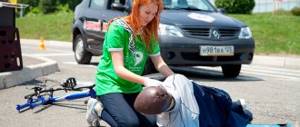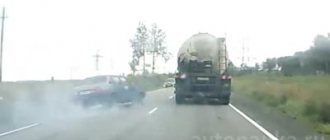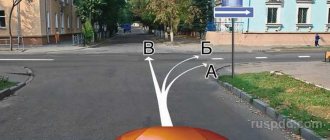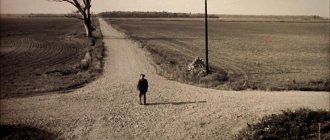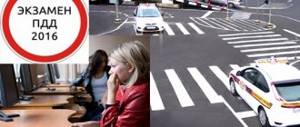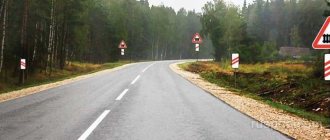Traffic rules of the Russian Federation 2021
STSI EXAMINATION TICKETS for categories “A”, “B”, “M” and subcategories “A1”, “B1”
on the topic Procedure for providing first aid to persons injured in an accident
TICKET 2. Question 20
| In what cases should cardiopulmonary resuscitation of the victim be started? Ticket 2, question 20. |
The correct answer is third. |
Comment: Cardiopulmonary resuscitation is carried out only if the victim has no signs of life. Signs of life are the presence of consciousness, pulse and breathing. If at least one of the signs of life is present, resuscitation is pointless, and its implementation can cause harm to a person’s health.
TICKET 3. Question 20
| What information must be provided to the dispatcher to call an ambulance in case of a road traffic accident (RTA)? Ticket 3, question 20. |
The correct answer is third. |
Comment: When calling an ambulance, it is necessary to provide information that will ensure the speedy arrival of doctors at the scene of an accident and the provision of the most effective assistance to victims. To do this, it is necessary to indicate as accurately as possible where the accident occurred and set clear landmarks on the ground. Reporting the number and general condition of the victims will allow you to make the right decision about how many ambulance teams and what qualifications should be sent to the scene of the incident.
TICKET 4. Question 20
| How should you place your hands on the victim's chest when performing cardiopulmonary resuscitation? Ticket 4, question 20. |
The correct answer is the second one. |
Comment: The human heart is located in the middle of the chest: behind the sternum, 2 fingers above its xiphoid process (the triangular bone with which the sternum ends). Performing chest compressions requires a lot of physical effort, so it is performed with both hands, which are placed one on top of the other. To prevent fractures of the sternum and ribs, these efforts should be directed along the axis of the sternum (thumbs pointing to the chin and abdomen).
TICKET 7. Question 20
| What is the optimal position for a conscious victim if a spinal injury is suspected? Ticket 7, question 20. |
The correct answer is the second one. |
Comment: The greatest danger in spinal injuries is the threat of damage to the spinal cord, which can occur with the slightest movement of the spinal column. Therefore, a victim with such an injury should absolutely not be moved or turned. To avoid damage to the cervical spine when moving the head, the neck must be secured with a homemade splint. If there is no splint, the neck is wrapped in a thick layer of cloth or a long scarf.
TICKET 8. Question 20
| How to provide first aid for frostbite and hypothermia? Ticket 8, question 20. |
The correct answer is the second one. |
Comment: In case of frostbite and hypothermia, it is necessary to minimize heat loss from the surface of the victim’s body. For this purpose, the affected areas of the body are insulated and immobilized, the victim is wrapped in warm clothes or a blanket, given a warm drink, and moved to a warm room. Giving alcohol in the cold is strictly prohibited, since first of all it dilates the blood vessels of the skin, increasing the release of heat by the body.
TICKET 10. Question 20
| What is the first aid for a traumatic brain injury accompanied by a wound to the scalp? Ticket 10, question 20. |
The correct answer is the first one. |
Comment: To stop bleeding when the head is wounded, a sterile pressure bandage is applied to the wound, and cold is applied to the wound area. A cervical splint immobilizes the victim’s head from unwanted movements. Since with head injuries there is always a suspicion of a concussion or contusion of the brain, which is often accompanied by nausea and vomiting, the victim should lie on his side.
TICKET 12. Question 20
| How should the victim be positioned if he loses consciousness and has breathing and circulation to provide first aid? Ticket 12, question 20. |
The correct answer is third. |
Comment: An unconscious victim should always lie on his side so that the root of the tongue, sunk into the larynx, does not block the airway and cause suffocation. The “recovery” position provides that the victim’s legs are bent at the knees and slightly pressed to the ground, and the back of his hand is placed under his cheek.
TICKET 13. Question 20
| For how long can a hemostatic tourniquet be applied? Ticket 13, question 20. |
The correct answer is the second one. |
Comment: A hemostatic tourniquet temporarily deprives the tissues located below the site of its application of normal blood supply, which leads to their necrosis. In the cold season, when blood vessels are already narrowed, this can happen faster. Therefore, in winter the tourniquet should be applied for a shorter period than in summer.
TICKET 15. Question 20
| What kind of injuries to the victim may be indicated by the “frog” pose (legs are bent at the knees and spread apart, and the feet are turned with the soles facing each other) and what first aid should be provided? Ticket 15, question 20. |
The correct answer is the second one. |
Comment: The “frog” pose is not related to injuries to the lower leg, ankle and foot - it is typical for injuries to the pelvis, lower spine and abdominal cavity. These injuries pose a great danger to human life and health, so they should not be aggravated by trying to change the position of the victim. In such cases, splints are not applied. First aid consists of fixing the “frog” pose, for which you need to place soft tissue rolls under your knees. It is also advisable to apply cold to the victim's stomach.
TICKET 16. Question 20
| How to determine whether a victim who has lost consciousness is breathing? Ticket 16, question 20. |
The correct answer is the second one. |
Comment: In a unconscious victim, breathing may not be detected due to the retraction of the tongue, blocking the flow of air into the respiratory tract. Therefore, to determine the presence of breathing, it is first necessary to restore the patient’s airway. To do this, you should put one hand on his forehead, and with two fingers of the other, raise his chin and throw back his head. Then, leaning towards his face, listen to his breathing for 10 seconds, try to feel the exhaled air with your cheek, determine the presence or absence of movement of the chest
TICKET 19. Question 20
| What needs to be done to remove a foreign body that has entered the victim’s respiratory tract? Ticket 19, question 20. |
The correct answer is third. |
Comment: A foreign object entering the respiratory tract causes suffocation and can lead to death within 2-3 minutes. To extract it, it is necessary to use special techniques that will not cause harm to the victim. Strikes with the heel of the palm between the shoulder blades in the direction of the neck are allowed. If this does not help, then you need to grab the victim from behind, press your chest against his back, clench your hand into a fist, clasp the fist with the other hand and apply several sharp and strong pressures on the upper abdomen in the direction of the chest.
TICKET 21. Question 20
| What are the signs of bleeding from a large artery and where does first aid begin when it is injured? Ticket 21, question 20. |
The correct answer is the second one. |
Comment: Large blood vessels - arteries - are filled with blood, which is rich in oxygen and therefore has a bright scarlet color. When an artery is damaged, rapid blood loss occurs, which can be fatal for the victim. In this case, blood is ejected from the wound in a pulsating stream. In such cases, you must immediately apply a hemostatic tourniquet 3-5 cm above the wound site. The tourniquet should be placed on a fabric lining and tightened with such force that the bleeding stops and the limb below the tourniquet turns pale. A blue limb indicates that the tourniquet is tightened too tightly.
TICKET 24. Question 20
| Is it allowed to give medications to the victim when providing first aid? Ticket 24, question 20. |
The correct answer is the second one. |
Comment: There are no medicines in the car first aid kit, since according to current legislation they are prohibited from being used in first aid. It is even more dangerous to give medications to an unconscious victim, since he does not have a swallowing reflex and any liquid or solid substance can enter the respiratory tract rather than the stomach.
TICKET 25. Question 20
| How to stop bleeding when a vein and small arteries are injured? Ticket 25, question 20. |
The correct answer is the first one. |
Comment: When veins and small arteries are injured, blood loss is not threatening and does not require the application of a hemostatic tourniquet. In such cases, a layer of sterile bandage is applied directly to the wound, a large amount of cotton wool or another rolled-up bandage is placed on it, after which the wound site is tightly bandaged - a pressure bandage is obtained.
TICKET 29. Question 20
| What are the initial steps to take when providing first aid in the event of an injury resulting from a road accident? Ticket 29, question 20. |
The correct answer is third. |
Comment: First aid for wounds is aimed at avoiding complications during wound healing, in particular, infection entering the body. Do not wash the wound, apply cotton wool to the damaged area or treat it with ointments. Antiseptic agents (iodine, brilliant green, etc.) can only be used to treat the skin around the wound. Apply a sterile napkin from the motorist's first aid kit to the wound itself, and use a bandage or tape to secure it. This work should be performed with medical gloves, which are first wiped with alcohol, cologne or unleaded gasoline.
TICKET 32. Question 20
| How to ensure restoration of the victim's airway when preparing him for cardiopulmonary resuscitation? Ticket 32, question 20. |
The correct answer is the first one. |
Comment: After cleaning the mouth, the best airway patency, facilitating artificial respiration, is ensured when the victim lies on his back with his head tilted back (if there is no damage to the cervical spine). To carry out artificial respiration using the mouth-to-mouth method, the victim’s lower jaw must be pushed forward. After this, access to the oral cavity will open.
TICKET 34. Question 20
| How is cardiopulmonary resuscitation performed on a victim? Ticket 34, question 20. |
The correct answer is third. |
Comment: When clinical death occurs, maintaining blood supply to vital organs is of primary importance. Therefore, cardiopulmonary resuscitation should begin with chest compressions, which is rhythmic and sharp manual pressure on the victim’s sternum, simulating the work of the heart. After 30 compressions, you can pause for a short time to take two breaths of artificial respiration, and then immediately resume chest compressions. Resuscitation cycles are repeated one after another, without stopping, until signs of life appear or until the ambulance team arrives.
TICKET 37. Question 20
| How is first aid provided for broken limbs if there are no transport tires and available means for their manufacture? Ticket 37, question 20. |
The correct answer is the second one. |
Comment: In case of fractures of the extremities, it is necessary to ensure complete immobility (immobilization) of the broken bones. If it is not possible to apply a splint, then the broken arm is carefully bent at the elbow and suspended from the neck using a scarf. For reliable fixation, the arm in this position is bandaged to the body. When a leg is broken, it is bandaged along its entire length to the other leg, after placing soft tissue between the legs to avoid disruption of the blood supply from prolonged compression. The bandaging at the fracture site should not be tight.
TICKET 38. Question 20
| In what cases should the victim be removed from the car? Ticket 38, question 20. |
The correct answer is the second one. |
Comment: A victim in an accident can be removed from the car until doctors or rescuers arrive only in cases that pose an immediate threat to his life. Such cases include the onset of clinical death, that is, the simultaneous absence of consciousness, pulse and breathing. Since resuscitation in a sitting position is not possible, the victim must be carefully removed from the vehicle and placed on a hard, horizontal surface.
TICKET 40. Question 20
| What is first aid if there are signs of a superficial thermal burn (redness and swelling of the skin, the formation of blisters filled with clear liquid at the burn site, severe pain)? Ticket 40, question 20. |
The correct answer is third. |
Comment: An attempt to open blisters, remove remnants of clothing, wash, lubricate or bandage the burn site can cause painful shock in the victim. Therefore, without treating the burn site, you need to cover it with a sterile napkin to avoid infection. To alleviate the condition of the victim, he is given painkillers that do not cause allergies, warmed up and given plenty of drinks of any kind. After applying the napkin, you need to carefully apply cold to the burn site.
Download tickets for PMP
Download the first aid manual for drivers
Memo on providing primary care
Changes in traffic rules exam cards dated April 10, 2018.
Views 33,780
04/11/2018 Hello to everyone who is preparing for traffic rules exams. In this material we will talk about changes in exam questions that are used when passing the traffic rules knowledge exam. The change affected 15 questions (medicine topic)
. All topics covered are updated in both the ABM category set and the CD set. The wording of questions and answers has changed, and some have been replaced with new ones.
Questions have changed (A, B, M)
: Ticket 2 question 20 | Ticket 3 question 20 | Ticket 4 question 20 | Ticket 7 question 20 | Ticket 8 question 20 | Ticket 10 question 20 | Ticket 12 question 20 | Ticket 16 question 20 | Ticket 19 question 20 | Ticket 21 question 20 | Ticket 29 question 20 | Ticket 32 question 20 | Ticket 34 question 20 | Ticket 38 question 20 | Ticket 40 question 20
Questions have changed (C, D, C1, D1)
: Ticket 2 question 20 |
Ticket 3 question 20 | Ticket 4 question 20 | Ticket 7 question 20 | Ticket 8 question 20 | Ticket 10 question 20 | Ticket 12 question 20 | Ticket 16 question 20 | Ticket 19 question 20 | Ticket 21 question 20 | Ticket 29 question 20 | Ticket 32 question 20 | Ticket 34 question 20 | Ticket 38 question 20 | Ticket 40 question 20 - In the green block, as it happened.
- In the red block, as it was. Let's look at the questions themselves.
Ticket 2 question number
20
In what cases should cardiopulmonary resuscitation of the victim be started?
1 If there is pain in the heart and difficulty breathing
2 In the absence of consciousness in the victim, regardless of the presence of breathing
3 In the absence of consciousness, breathing and blood circulation in the victim.
Ticket 2 question number
20
When should cardiopulmonary resuscitation of a victim be started?
1 If there is pain in the heart area and difficulty breathing.
2 If the victim loses consciousness, regardless of the presence of a pulse in the carotid artery and signs of breathing.
3 If the victim loses consciousness and there is no pulse in the carotid artery, as well as signs of breathing.
There have been minor changes to the text of the question and answers
Ticket 3 question number
20
What information must be provided to the dispatcher to call an ambulance in case of a road traffic accident (RTA)?
1 Indicate well-known landmarks closest to the accident site. Report the number of victims, indicate their gender and age.
2 Indicate the street and house number closest to the accident site. Report who was injured in the accident (pedestrian, car driver or passengers) and describe the injuries they received.
3 Indicate the location of the accident (name the street, house number and well-known landmarks closest to the accident site). Report: the number of victims, their gender, approximate age, whether they have consciousness, breathing, blood circulation, as well as severe bleeding, fractures and other injuries. Wait for a message from the dispatcher that the call has been accepted.
Ticket 3 question number
20
What information must be provided to the dispatcher to call an ambulance in case of an accident?
1 Indicate well-known landmarks closest to the accident site. Report the number of victims, indicate their gender and age.
2 Indicate the street and house number closest to the accident site. Report who was injured in the accident (pedestrian, car driver or passengers), and describe the injuries they received.
3 Indicate the exact location of the accident (name the street, house number and well-known landmarks closest to the accident site). Report the number of victims, their gender, approximate age and whether they have signs of life, as well as severe bleeding.
There have been minor changes to the text of the question and answers
Ticket 4 question number
20
How should you place your hands on the victim's chest when performing cardiopulmonary resuscitation?
1 The bases of the palms of both hands, taken in a “lock,” should be located on the chest two fingers above the xiphoid process so that the thumb of one hand points towards the victim’s left shoulder, and the other towards the right shoulder. The arms are straightened at the elbow joints.
2 The base of the palm of one hand is placed on the middle of the chest two fingers above the xiphoid process, the second hand is placed on top, the fingers are locked. The arms are straightened at the elbow joints, the thumbs pointing to the chin and stomach. Pressure should be carried out without sudden movements.
3 Hand pressure on the sternum is performed with the heel of the palm of one hand located on the chest two fingers above the xiphoid process. The arm is straightened at the elbow joint. The direction of the thumb does not matter.
Ticket 4 question number
20
How should you place your hands on the victim’s chest when applying pressure with your hands on his sternum (performing chest compressions)?
1 The bases of the palms of both hands should be located on the chest two fingers above the xiphoid process so that the thumb of one hand points towards the victim’s left shoulder, and the other towards the right shoulder.
2 The bases of the palms of both hands, which overlap one another, should be located on the chest two fingers above the xiphoid process so that the thumb of one hand points towards the victim’s chin, and the other towards the abdomen.
3 Hand pressure on the sternum is performed with the heel of the palm of only one hand, located on the chest two fingers above the xiphoid process. The direction of the thumb does not matter.
There have been minor changes to the text of the question and answers
Ticket 7 question number
20
What is the optimal position for a conscious victim if a spinal injury is suspected?
1 Lay the victim on his side.
2 Lay the victim on his back on a hard, flat surface, do not move him unless necessary, do not change his position.
3 Lay the victim on his back, place a cushion of clothing under his neck and raise his legs.
Ticket 7 question number
20
What is first aid for a conscious victim with a spinal injury?
1 Lay the victim on his side.
2 Do not move a lying victim. An improvised cervical splint should be placed on his neck without changing the position of the neck and body.
3 For the victim lying on his back, place a cushion of clothing under his neck and raise his legs.
There have been minor changes to the text of the question and answers
Ticket 8 question number
20
How to provide first aid for frostbite and hypothermia?
1 Rub the affected areas of the body with snow or wool, then insulate them, give them alcohol, and move them to a warm room.
2 Insulate the affected areas of the body and immobilize them, wrap the victim in warm clothes or a blanket, give a warm drink, and move to a warm room.
3 Lubricate the affected areas of the body with cream, apply a warm compress and a heating pad, move to a warm room, and give a warm drink.
Ticket 8 question number
20
In case of an open fracture of the limbs, accompanied by arterial bleeding, first aid begins:
1 With the application of an improvised splint.
2 Applying a tourniquet above the wound at the fracture site.
3 With the application of a pressure bandage.
The question has been completely changed. Previously there was a question about a fracture, now the question is about frostbite and hypothermia.
Ticket 10 question number
20
What is the first aid for a traumatic brain injury accompanied by a wound to the scalp?
1 Stop bleeding with direct pressure on the wound and apply a pressure bandage. If you lose consciousness, place yourself in a stable lateral position. If possible, apply cold to the head.
2 Fix the cervical spine using an improvised cervical splint (collar). Apply a sterile cotton swab to the wound and place the victim on his back with his legs elevated. If possible, apply cold to the head.
3 Do not apply a cervical splint, seal the wound with a medical plaster, and lay the victim on his side.
Ticket 10 question number
20
What is the first aid for a traumatic brain injury accompanied by a wound to the scalp?
1 Apply an improvised neck splint. Apply a pressure bandage made of a sterile bandage to the wound of the scalp, lay the victim on his side with his knees bent, and, if possible, apply cold to the head.
2 Apply an improvised neck splint, apply a sterile cotton swab to the wound, place the victim on his back with his legs elevated. If possible, apply cold to the head.
3 Do not apply a cervical splint, seal the wound with a medical plaster, and place the victim on his side only if he loses consciousness.
There have been minor changes to the text of the question and answers
Ticket 12 question number
20
How should the victim be positioned if he loses consciousness and has breathing and circulation to provide first aid?
1 On your back with a cushion placed under your head.
2 On your back with your legs extended.
3 Place the victim in a stable lateral position so that the knees are bent on the ground and the upper hand is under the cheek.
Ticket 12 question number
20
How should the victim be positioned if he loses consciousness and there is a pulse in the carotid artery to provide first aid?
1 On your back with a cushion placed under your head.
2 On your back with your legs extended.
3 On your side so that your bent knees rest on the ground and your top hand is under your cheek.
There have been minor changes to the text of the question and answers
Ticket 16 question number
20
How to determine whether a victim who has lost consciousness is breathing?
1 Take the victim by the chin, tilt his head back and watch the movement of his chest for 10 seconds.
2 Place one hand on the victim’s forehead, lift the chin with two fingers of the other and, throwing back your head, lean towards his face and listen to his breathing for 10 seconds, try to feel the exhaled air with your cheek, follow the movement of the chest.
3 Without throwing back the victim’s head, lean towards his face and listen to his breathing for 10 seconds, feel it with your cheek, and follow the movement of his chest.
Ticket 16 question number
20
How to determine the presence of a pulse in the victim’s carotid artery?
1 Three fingers are placed on the left side of the neck under the lower jaw.
2 Three fingers are placed on the right or left side of the neck at the level of the thyroid cartilage of the larynx (Adam’s apple) and carefully moved deep into the neck between the thyroid cartilage and the muscle closest to the cartilage.
3 The thumb is placed on the neck under the chin on one side of the larynx, and the remaining fingers on the other side.
The question has been completely changed. Previously there was a question about the presence of a pulse, now the question is about the presence of breathing.
Ticket 19 question number
20
What needs to be done to remove a foreign body that has entered the victim’s respiratory tract?
1 Place the victim face down on your knee and punch him in the back several times.
2 Induce vomiting by pressing on the root of the tongue. If the result is negative, hit the victim’s back with the edge of your palm or stand in front and press firmly with your fist on his stomach.
3 Stand on the side of the victim, supporting him with one hand under the chest, with the other hand tilt the victim’s body forward head down. Apply five sharp blows with the heel of your palm to the area between the shoulder blades. If the result is negative, stand from behind, grab it with both hands just above the navel, clasp your hands and sharply press five times on the abdominal area inward and upward.
Ticket 19 question number
20
What needs to be done to remove a foreign body that has entered the victim’s respiratory tract?
1 Place the victim face down on your knee and punch him on the back several times.
2 Induce vomiting by pressing on the root of the tongue. If the result is negative, hit the victim’s back with the edge of your palm or stand in front and press firmly with your fist on his stomach.
3 Hit the victim’s back several times with your palm. If the result is negative, stand behind him, grab him with both hands at the level of the lower ribs, clasp your hands, simultaneously squeeze his ribs and sharply press on the abdominal area inward and upward.
There have been minor changes to the response text
Ticket 21 question number
20
What are the signs of bleeding from a large artery and where does first aid begin when it is injured?
1 Dark blood flows out of the wound slowly. A pressure bandage is applied to the wound, with a note indicating the time of application of the bandage.
2 Bright scarlet blood flows from the wound in a pulsating or gushing stream. The artery is pressed with the fingers, then at the points of pressure above the wound, as close as possible to it, a hemostatic tourniquet is applied, indicating in the note the time of application of the tourniquet.
3 Blood flows out of the wound slowly. A hemostatic tourniquet is applied below the wound site, with the note indicating the time of application of the tourniquet.
Ticket 21 question number
20
What are the signs of bleeding from a large artery and first aid for its injury?
1 Clothing quickly becomes saturated with blood, dark-colored blood flows out of the wound passively. A pressure bandage is applied to the wound site.
2 The clothes are soaked in blood, scarlet blood flows out of the wound in a pulsating stream. A hemostatic tourniquet is applied above the wound site at least 3-5 cm.
3 Clothing is soaked in blood only at the site of the wound (the color of the blood does not matter), the blood flows out of the wound passively. A hemostatic tourniquet is applied below the wound site at least 3-5 cm.
There have been minor changes to the text of the question and answers
Ticket 29 question number
20
What are the initial steps to take when providing first aid in the event of an injury resulting from a road accident?
1 Wash the wound with water, remove foreign bodies embedded in the wound, apply sterile cotton wool, securing it with a bandage.
2 Put on medical gloves, wash the wound with an alcohol solution of iodine, lubricate it with medicinal ointment and seal it with a continuous adhesive plaster.
3 Wear medical gloves, do not wash the wound, apply a sterile gauze napkin to the wound, securing it with an adhesive plaster around the edges or a bandage.
Ticket 29 question number
20
How to provide first aid if injured as a result of an accident?
1 Wash the wound with water, remove foreign bodies embedded in the wound, apply sterile cotton wool, securing it with a bandage.
2 Put on medical gloves, wash the wound with an alcohol solution of iodine, lubricate it with medicinal ointment and seal it with a continuous adhesive plaster.
3 Wear medical gloves, do not wash the wound, apply a sterile gauze pad to the wound, securing it with an adhesive plaster around the edges and a bandage.
There have been minor changes to the text of the question and answers
Ticket 32 question number
20
How to ensure restoration of the victim's airway when preparing him for cardiopulmonary resuscitation?
1 Lay the victim on his back on a hard surface, tilt his head back, place one hand on his forehead, lifting his chin with two fingers of the other hand.
2 Lay the victim on his side, tilt his head to his chest. If there is mucus and vomit, clean the mouth from them.
3 Lay the victim on his back and, without throwing his head back, squeeze his cheeks to spread his lips and open his mouth. If there is mucus and vomit, clean the mouth from them.
Ticket 32 question number
20
How to ensure restoration and maintenance of the victim’s airway when preparing for cardiopulmonary resuscitation?
1 Clear the oral cavity of mucus and vomit. Lay the victim on his back, tilt his head back, lift his chin and extend his lower jaw.
2 Lay the victim on his side, tilt his head to his chest. Clear the oral cavity of mucus and vomit.
3 Lay the victim on his back and, without throwing his head back, squeeze his cheeks to part his lips and open his mouth. Clear the oral cavity of mucus and vomit.
There have been minor changes to the text of the question and answers
Ticket 34 question number
20
How is cardiopulmonary resuscitation performed on a victim?
1 Artificial respiration and manual pressure on the victim’s sternum: first, 1 breath using the “mouth to mouth” method, then 15 pressures on the sternum.
2 Hand pressure on the victim’s sternum and artificial respiration: first 15 pressures on the sternum, then 1 breath using the “mouth to mouth” method.
3 Hand pressure on the victim’s sternum and artificial respiration: first 30 pressures on the sternum, then 2 breaths using the “mouth to mouth” method.
Ticket 34 question number
20
How is cardiopulmonary resuscitation performed on a victim?
1 Artificial ventilation and manual pressure on the victim’s sternum: first, 1 breath using the “mouth to mouth” method, then 15 pressures on the sternum.
2 Hand pressure on the victim’s sternum and artificial ventilation: first 5 pressures on the sternum, then 1 breath using the “mouth to mouth” method.
3 Hand pressure on the victim’s sternum and artificial ventilation: first 30 pressures on the sternum, then 2 breaths using the “mouth to mouth” method.
There have been minor changes to the text of the answers
Ticket 38 question number
20
In what cases should the victim be removed from the car?
1 If there is a high probability of a vehicle overturning, a fire, an explosion, or if the victim loses consciousness.
2 If there is a high probability of a car rollover, fire, explosion, hypothermia of the victim, in the absence of consciousness and breathing, as well as the impossibility of providing first aid directly inside the car.
3 If there is a high risk of vehicle rollover, fire, explosion, or severe bleeding or traumatic brain injury.
Ticket 38 question number
20
In what cases should the victim be removed from the car?
1 For fractures of the limbs.
2 If the victim loses consciousness, has no pulse in the carotid artery, and no signs of breathing.
3 With heavy bleeding.
There have been changes to the text of the question and answers
Ticket 40 question number
20
What is first aid if there are signs of a superficial thermal burn (redness and swelling of the skin, the formation of blisters filled with clear liquid at the burn site, severe pain)?
1 Pour cold water over the burn surface, cover with a sterile cloth and bandage tightly.
2 Open the burn blisters, clean the burn surface from remnants of clothing, cover with a sterile cloth (do not bandage), apply cold if possible, and give the victim water to drink.
3 Cool the burnt surface with water for 20 minutes. Do not open burn blisters, do not remove remnants of clothing from the burned surface, cover the burn site with a sterile napkin (do not bandage), apply cold if possible and give the victim water to drink.
Ticket 40 question number
20
What is first aid if there are signs of a second-degree thermal burn (redness and swelling of the skin, the formation of fluid-filled blisters at the burn site, severe pain)?
1 Pour cold water over the burn surface, cover with a sterile cloth and bandage tightly.
2 Open the blisters, clean the burn surface from remnants of clothing, cover with a sterile napkin (do not bandage), apply cold if possible, and give the victim water to drink.
3 Do not open blisters, do not remove remnants of clothing from the burned surface, cover the wound with a sterile cloth (do not bandage), apply cold if possible and give the victim water to drink.
There have been changes to the text of the question and answers
On our website you can prepare for a theoretical exam on traffic rules.
Study traffic rules tickets on the main page of the site More from the section changing traffic rules.
Change in the Code of Administrative Offenses of May 1, 2021 New traffic police fines at railway crossings
New deadlines for retaking exams in the traffic police from April 1, 2021
Cancellation of exams at the circuit from April 1, 2021
Changes to traffic rules from March 1, 2021
Changes to traffic rules from April 8, 2021
Changes in traffic rules exam cards dated January 2, 2020.

